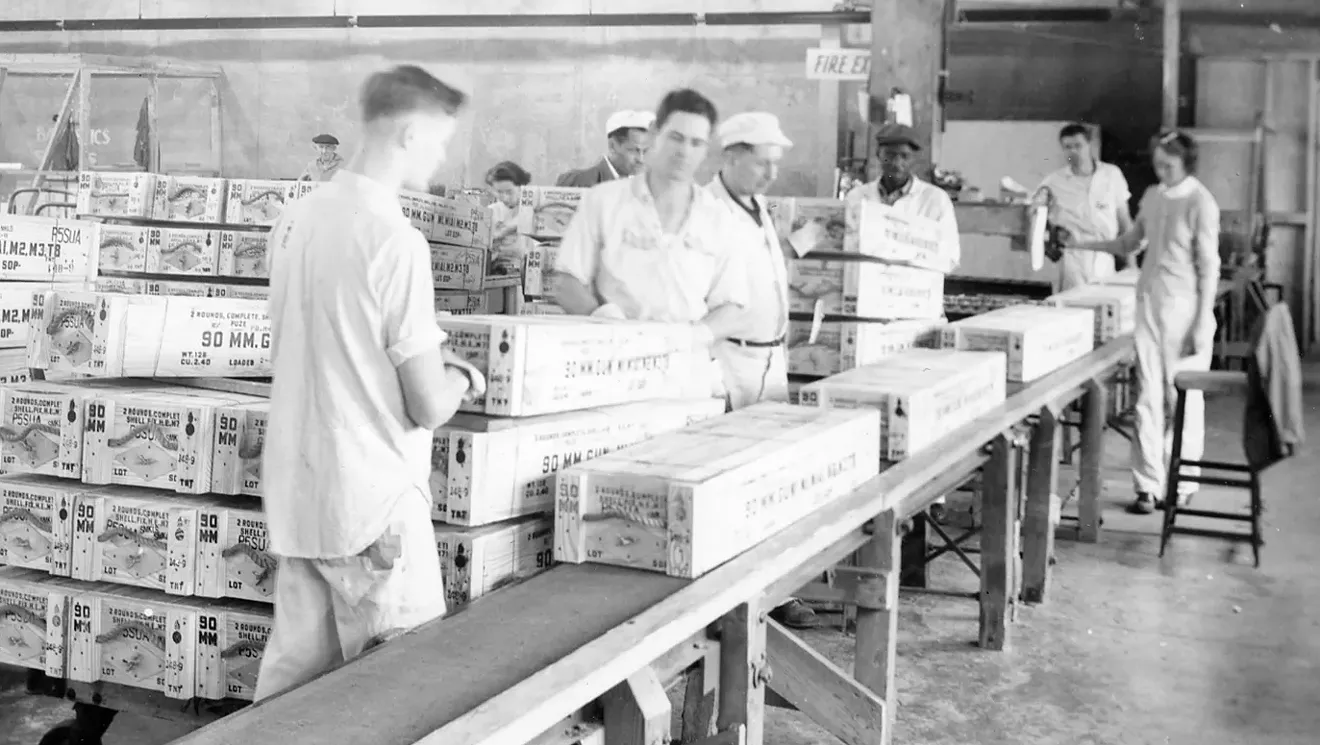
Author event Thelma L. Ball will be speaking at Books on the Square, 427 E. Washington St., Springfield, on Friday, Aug. 22, at 1 pm. Copies of the book are available at the store.
Thelma L. Ball, compiler, Illinois Munitions: A News Journal of the Oak & Sangamon Ordnance Plants, 1942-1950, Illiopolis, Illinois. Self-published, 2025. 350 pp., illustrations, newspaper list, index.
Illiopolis today considers itself a village, with a population of 846 recorded in the 2020 census. It was even smaller in 1942 – about 700 people – when the U.S. government decided to force the purchase of 19,000 acres of nearby farmland as a site for two large ordnance plants.
A new book, Illinois Munitions: A News Journal of the Oak & Sangamon Ordnance Plants, compiled and self-published by Thelma L. Ball, tells the story of those ordnance plants through newspaper clippings from the era. It is based primarily on articles and photos from the Decatur Herald and Decatur Review, supplemented by material from 20 other papers. This makes sense, as Decatur was the nearest larger city, 16 miles away. Springfield was only about 28 miles to the west, but, for reasons not explained by the compiler, there are no articles from any Springfield newspapers.
First reports of a possible ordnance plant near Illiopolis appeared in mid-February 1942 and the site, on both sides of Route 36, was soon selected. At least some farmers were not happy to lose their prime agricultural land to war industries, but they had no say in the matter. Construction began on the Oak Ordnance Plant first. Although government-owned, the plant would be managed by the Midland Ordnance Foundation, a subsidiary of Johnson & Johnson. It was completed about Sept. 2 and assembled artillery shells from parts made elsewhere.
The Sangamon Ordnance Plant was constructed across Route 36 (on the south side). With assembly lines to prepare fuses and boosters for ammunition, the Sangamon plant was managed by Remington Rand. Although not completed until March 1943, Sangamon began manufacturing in December 1942. Each plant complex included hundreds of buildings for various purposes: assembly lines, cafeterias, storage areas for munitions parts and completed items, laundry facilities, administration, and staff housing.
Initial estimates expected the plants to employ 15,000 people. Employment figures were not released, but at times may have been as high as 13,500. Although considered to be important war work, jobs at the Illiopolis plants were not exempt from military service, so there was continual turnover and a general shortage of men to do various types of heavy lifting and loading. On some occasions, troops were brought in from Fort Ellis to do this work temporarily. The plants were eager to hire women for many positions, especially assembly line work. Many job advertisements over the years tried to appeal to homemakers and girls who had not previously been employed outside the home. Any girl with reasonable intelligence and manual dexterity ought to be able to do the job, they said. Altogether women made up about 65% of the work force at the plants. They were nicknamed “WOWs,” short for Women Ordnance Workers.
About the beginning of September 1943, the two plants merged under the Sangamon name with Remington Rand management. They continued the manufacture of their distinct items, however.
Before the merger, most articles collected described facets of work at the Oak Plant. Lengthy articles appeared monthly, with photographs detailing specific parts of the plant, such as an assembly line, the cafeteria, and health care provisions (including a hospital). The plant even provided low-cost nursery care for children from age three, whose mothers worked at the plant.
Locating such large installations near such a small town necessitated housing and transportation arrangements. Many workers commuted by train on the Illinois Terminal Railroad from Springfield and Decatur, or by bus from Taylorville. The trains increased their passenger capacity by using reconditioned cars previously retired from the New York City “El” system. Some extra gas ration coupons could be provided to a limited number of carpoolers from other locations. Workers from beyond commuting range could be housed in dormitories on the plant campus.
The articles included in this book are raw data. There are no introductions, summaries, explanations, assessments, discussions, elaborations, annotations or conclusions. This is reading the newspapers for then-current local, plant-related events, and it is interesting reading. Not every article is about plant operations. At least in the earlier years there were quite a few social and recreational events. Names of participants are often included.
Although the plant ceased production immediately after the victory over Japan, articles explain how a remnant of employees worked for many months decontaminating the area and preparing surplus equipment for sale. Eventually, displaced farmers were allowed to buy back the land they had had to sell, and most of them did so. The book closes with several contemporary photos of remaining plant structures among the cornfields.
This book should be of interest to people whose relatives and friends worked at the plant, of course. But readers with an interest in the World War II home front, labor history and central Illinois in the 20th century will find much to fascinate them as well. It would also be a good starting place for further research.
Springfield historian Glenna R. Schroeder-Lein, a retired manuscripts librarian, does freelance editorial work, and writes occasional book reviews for Illinois Times.


